"The $300 Epiphone that I have, it’s one of my most faithful and greatest soldiers" – Josh Homme, Dave Grohl and Alain Johannes talk Them Crooked Vultures and affordable gear
Classic interview from 2010: "It’s the best hammer I have in my tool bag, because that’s what I do: I hammer"

This interview was conducted and first published in 2010
To some it was a dream band come true, to others it was entirely incongruous – a combination of Led Zeppelin multi-instrumentalist John Paul Jones and ex-Nirvana man/Foo Fighter Dave Grohl. Jones’ legacy, already globally established with Zeppelin and brought back to the fore with the band’s one-off London O2 reunion in 2007, forms the core of rock’s very foundation.
Likewise, Grohl is no stranger to success, whether behind the drums for Nirvana, pulsing out the beats on the Queens Of The Stone Age classic Songs For The Deaf, or as frontman of the world-conquering Foo Fighters.
How to top off this seismic rhythm machine might be a little more complex. Even if it seemed a logical move to introduce ex-Kyuss/stoner rock legend and QOTSA leader Josh Homme, who’s to say the chemistry would work?
Homme is well used to side projects, not least Eagles Of Death Metal and his lauded Desert Sessions – his prowess as a guitarist straddling the difficult bedfellows of slamming heavy riffs and intricate counter-melody and texture.
Alain Johannes, no stranger to Homme/Grohl liaisons and other big collaborations, was the last piece of the jigsaw, brought in to cover guitar and bass live (he also contributed to the album).
I’ve never played like this before because I’ve never played with someone like that!
Dave Gohl on John Paul Jones
We caught up with them on their recent UK tour, amid soundchecks, pre-gig prep and impromptu jams. “I’ve never played like this before,” enthuses Grohl of JPJ, “because I’ve never played with someone like that! I love listening to disco just as much as I like listening to AC/DC, both for the same reason.
Want all the hottest music and gear news, reviews, deals, features and more, direct to your inbox? Sign up here.
They’re both entirely different, but the same, in that it’s based on this simple groove foundation. John and I connected in that and like to groove together. Zeppelin were famous for mixing styles with really dirty blues/hard rock. That injected a lot of fun into what we were doing.”
And Homme? “Josh can be dark and Josh can come from a heavy, deep place, but with John and I underneath making peoples asses shake, it’s the perfect balance of those things where you really enjoy going to this fucked up place and the two of us can do that in a fluid manner – playfully too.” Well then, let’s get down to business…
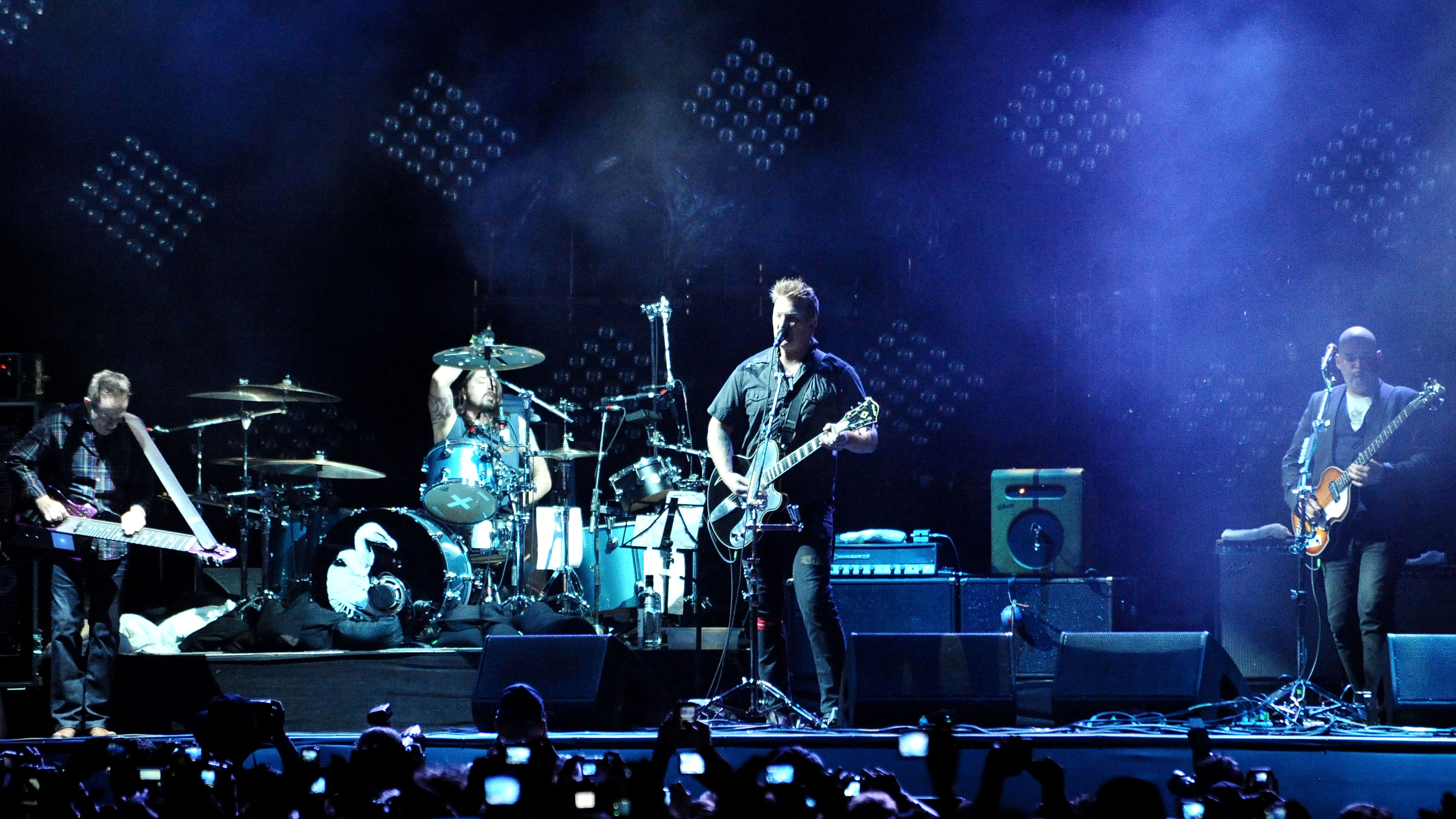
It was never about whose idea it was, it was more about what idea
Dave Grohl
So much talent, one studio and control room – how on earth did that work?
Dave Grohl: “It was funny going into the studio with three multi-instrumentalists who’ve all written and produced albums. You just walk into the room, see what happens and you let the dynamic create itself. There wasn’t really any discussion. If someone had a riff you could say, Hey I have this idea, and I’d pick up a guitar and start playing something, Josh would pick up a guitar and start playing along and John would pick up a bass or mandolin or…”
Some weird thing, perhaps?
Dave Grohl: “Yeah! And we’d start playing. If we really thought it was worth pursuing, we’d put the instruments down and walk into the big room, plug in, turn on and then jam. It was never about whose idea it was, it was more about what idea.
Josh Homme: “Recording-wise, I always like it raw, that’s my preference. When you listen to a Creedence Clearwater Revival album it sounds better and more current than a current album, in my opinion. It’s natural, it’s timeless and its tonality sounds great as you turn it up, or even when it’s down. Those are the key factors to great production value in my mind. Much of the eighties gated reverb stuff for snares and things such as that, they don’t really travel the same way.”
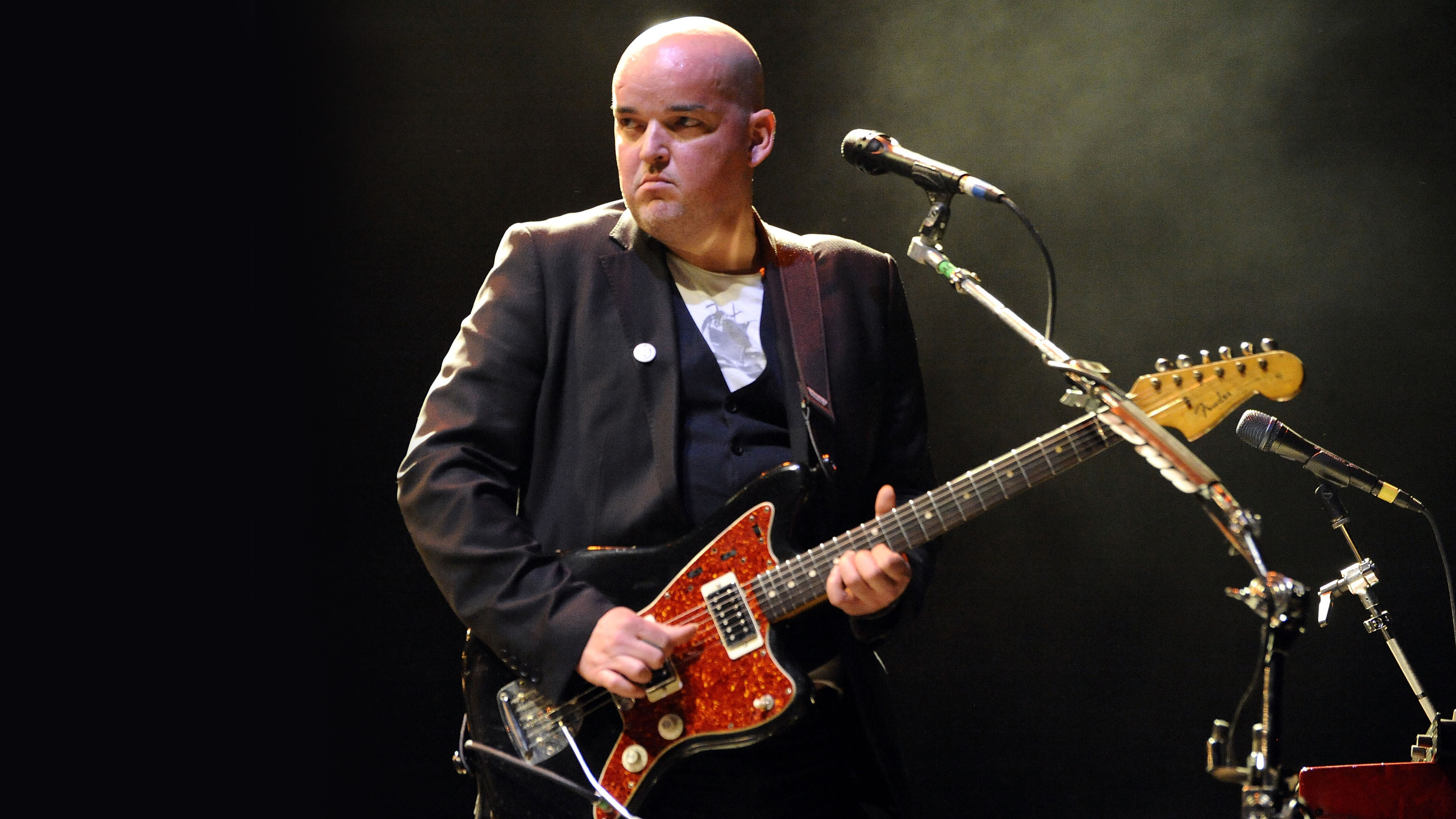
Alain Johannes is the fourth quarter of Them Crooked Vultures and, like the songwriting trio of Grohl, Jones and Homme, he’s much more than a guitar player doing the second guitar parts. Josh Homme is quick to point out his standing as part of the live act. “I brought Al to the interview because he recorded all those guitars on the album, he’s the best guitar player in our band.”
His guitar rack is similarly equipped to Homme’s, with some neat twists. As well as a MotorAve guitar, there’s a prototype vintage arched back (yes, arched back) Les Paul, a 1968 Fender Jazzmaster and a Gibson SG that tech Ally Christie claims is the only year of SG that Angus Young doesn’t have! A three-quarter scale bass equipped with flatwounds also makes an appearance when JPJ is using one of his alternative instruments. Johannes was one of the founders of the critically acclaimed band Eleven, and as a producer and engineer has worked with artists from The Arctic Monkeys to Chris Cornell.
Dave Grohl: “There was one track we didn’t put on the album, Highway One, which we play in the live set, and it illustrates how things went sometimes. Josh has many ideas and he’s never short of a riff. That was the first e-mail I sent to him after we started jamming. I said, Look we can fill the Grand Canyon with riffs, but what we need to do is write songs. So instead of this being like some riffathon, let’s write and arrange some really good songs that people will sing and will be memorable. So we were recording plenty of Josh’s ideas; Daffodils started with a Josh riff, Scumbag Blues was basically a jam, as was Caligulove.
"After maybe a month, John said, I’ve got some riffs, do you want to hear some? Fuck, yeah! So he plays the riff to Highway One and we’re saying, Oh. My. God. Do you have any more of those!? “It was nice to be able to go in the studio and have such a natural recording process. It was just perfect; just as you hoped it would be.”
Josh Homme: “And when it came to the actual project, Al and I are very symbiotic as a creative team. It’s tough to say where one title ends and the next begins with producing, recording or engineering. They’re all the same things in our world.”
Dave, weren’t you tempted to grab a guitar and lay down some tracks?
Dave Grohl: “Not really. It’s not unlike Nirvana. When I was in that band I loved being just the drummer, because it was a very simple machine that we had. It was a guitarist who played no lead and mainly barre chords, a bass player that played really simple, melodic, rhythmic basslines and me. And I was being the drummer of AC/DC or the drummer of Chic, or even the drummer of The Gap Band! That was my responsibility and that dynamic worked.
"There’s the famous joke: What was the last thing the drummer said before they kicked him out of the band? Hey guys I have a song I think we should play! So once we established that dynamic between John, Josh and I, it made sense for me to plant my feet there and say, Okay, I’ll be your foundation to make sure that everyone moves in that direction.
“There were a couple of things we recorded that were ideas of mine – acoustic things. Actually the first riff we got down was a guitar line that I’d written as an arpeggiated acoustic thing, which the three of us sat down and recorded with a mic. That was a nice way to break the ice, because John was playing mandolin, Josh was playing acoustic guitar and so was I. If the drummer wants to play acoustic guitar and write a song, that’s okay, and if John wants to whip out a mandolin and sing a song that’s okay – there were no rules.”
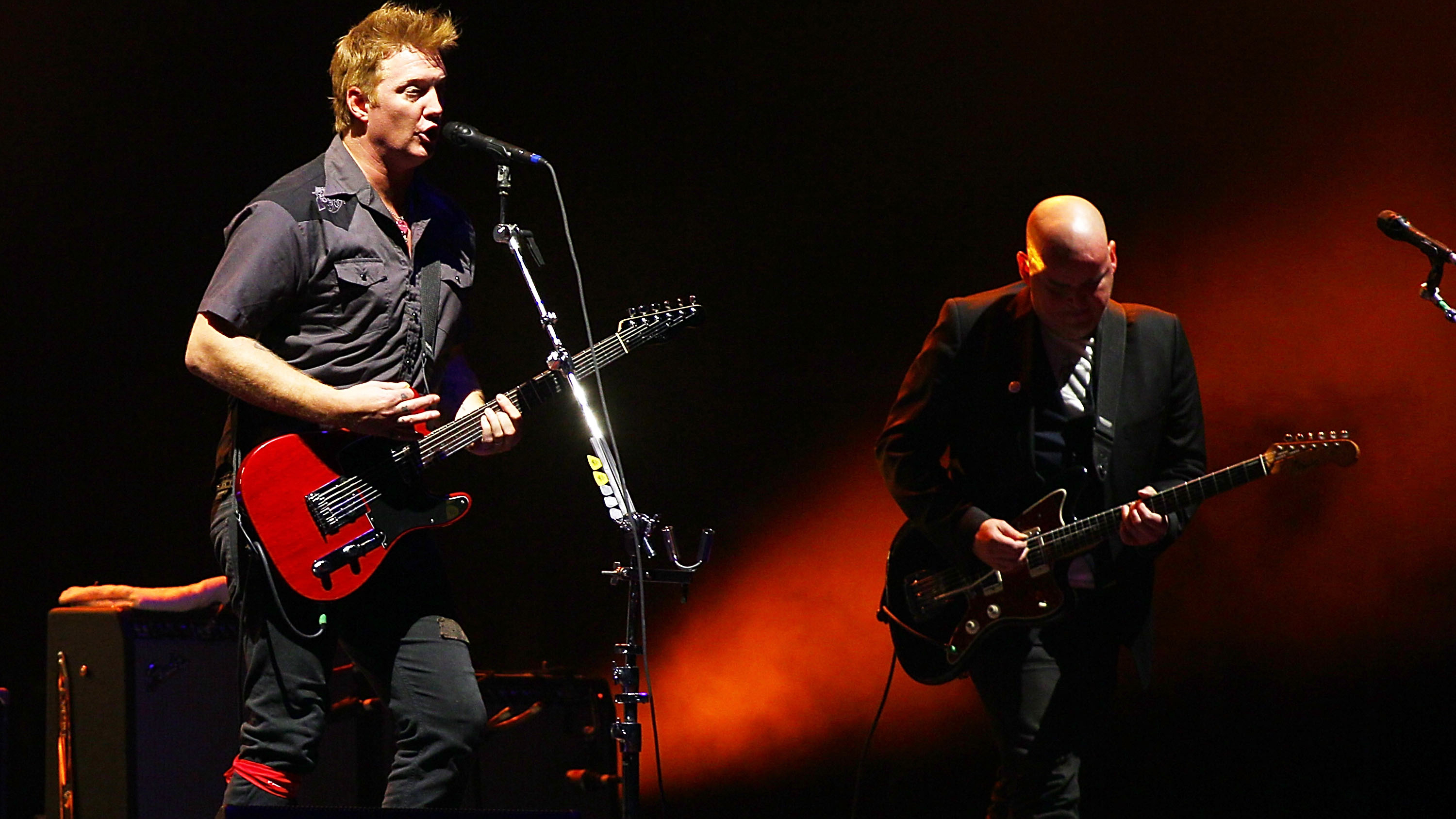
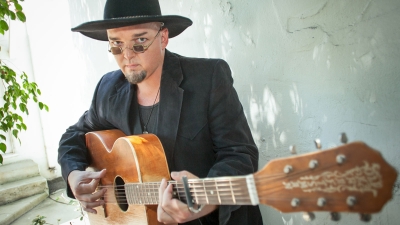
Alain Johannes talks lessons learned with Homme, Cornell and Lanegan
Let’s talk guitars. Josh, you’re sometimes quite secretive about your rigs…
Josh Homme: “I’m going to tell you everything about my rig! But we’ll start with Al’s…
Alain Johannes: “Basically, it’s a Fender Super Reverb and Twin Reverb running together with a nice collection of Moogerfoogers, delays and various gain stages that have tonal qualities and then a wah and volume…”
Josh Homme: “You’re great at controlling those distortions, those different gain stages. It’s easy to turn up a pedal that gains itself all the way up to, bleurghhhh, but to have control over what’s happening? Al is the only rock guy I know who plays with Django Reinhardt-style inflections. We’re into a lot of Class A, Super Hard On-style pedals.”
You mean the Z-Vex units?
Josh Homme: “We like gear that might normally be in a desk somewhere to get gain for your guitar, rather than use distortion, which is simply compressing the sound and then dirtying up that, louder. This notion of shrinking it down and then turning it up ends up being just that, butsuper loud. That’s a very cheeky way to get through it – like you’re not thinking at all.
"The Fulltone pedal [see more at the end of the interview] is really great. It’s like steroids more than anything else – which I don’t condone, ha – but I do think you should use them for guitar. Al, what’s that little red box in your rig?”
Alain Johannes: “The DI splitter for my bass?”
Josh Homme: “No, that’s a Red Box (legendary Hughes And Kettner DI). Maybe it’s silver, with the four knobs…”
Are we talking about the unusual pedals that are sat on top of the amps here?
Josh Homme: “I use a Teisco Checkmate 25 head and the pedals are there to drive the midrange, because as you boost the bass and treble, it creates a mid-range shift and I like a little bit more carve. Sometimes I’ll take the level control on an EQ pedal and turn it up. If it wasn’t capable of driving a 4x12 cabinet before, it is now! For the last bunch of years I’ve always had a little Maestro or some kind of EQ that’s always on, such as a Maestro Parametric.”
The $300 Epiphone that I have, it’s one of my most faithful and greatest soldiers. It’s the best hammer I have in my tool bag, because that’s what I do: I hammer
We notice you seem to shun the whole vintage, legendary guitars that are so desirable, or even the modern equivalents – why is that?
Josh Homme: “The $300 Epiphone that I have, it’s one of my most faithful and greatest soldiers. It’s the best hammer I have in my tool bag, because that’s what I do: I hammer. I’m self-trained and I play because that’s my religion: music.”
Have you ever played a vintage instrument and been blown away by it?
Josh Homme: “I have a Gibson ES-225, which I really like. Of course it’s the noncollectable model in the Gibson series, because there’s a dog-eared P-90 in the centre position, but that’s a great position, because it has the milkiness of the neck sound and enough cut from the treble position. It also works great acoustically, so you can mic it as an acoustic and add this extra pluck to the tonality.”
Alain Johannes: “It’s amazing the instruments that are magic for some reason, they just are, and yet I’ve played some expensive instruments that were just useless except for their market value.”
Josh Homme: “They’re glass case material! We don’t have any display items. I have a ’65 Teisco that will rip your ears off. We have a philosophy, which is about using the worst stuff incorrectly; it just disproves ‘two wrongs don’t make a right’, because you can absolutely do that. That Teisco for example – is that the best guitar ever made? It’s terrible, but there’s something to that; it’s got a certain thing.”
Alain Johannes: “You just plug it in and go. The sound is somehow exactly what you are looking for. All the $1,000 stuff can be completely useless for the purpose.”
Josh Homme: “That goes for amps too. I’m doing what I’ve already heard a number of times from guitar people is blasphemy. I have a 1938 Gibson EH-185 [amp] on the road. There are probably no more than 400 of them and this is the most mint condition one I’ve ever seen. And it’s out here! The other night I tripped and spilt vodka on it. It shouldn’t drive, but that’s not the point. These things aren’t meant to be wiped with a diaper.”
Dave Grohl: “My [guitar] rig has always been really simple. In the studio I stick to AC30s and Hi-Watt gear. Sometimes I’ll use Mesa gear, but I mostly use Mesa live, as it never goes down. I have an MXR Phase 90 and a Boss Digital Delay pedal.”
So it’s like the opposite to Josh’s rig?
Dave Grohl: “I don’t go there!”
I’m not a tech guy and I don’t know much about gear, but when you wrap your hands around a Dan Armstrong neck you kind of feel invincible
Dave Grohl
What about the see-through Dan Armstrong you play, Dave?
Dave Grohl: “[That] was the guitar that one of my heroes played: Greg Ginn from Black Flag. I think Keith Richards was playing them too, but to me those early Black Flag records and shows were such a huge influence on my early musical upbringing.
"They were musical heroes of mine because they were so fucked up. The Dan Armstrong seemed like the anti-guitar; it seems like something that shouldn’t be a guitar. It’s Lucite and it’s heavy. When I started playing one I really liked the feel of the neck. They differ. I’m not a tech guy and I don’t know much about gear, but when you wrap your hands around a Dan Armstrong neck you kind of feel invincible, it’s almost effortless the things you can do and it’s weird the way it hangs on you, the interchangeable pickups too.
"It’s maybe not the greatest sounding guitar, but when you play it, you’re playing it for a reason and you feel like… like a weird space criminal or something!”
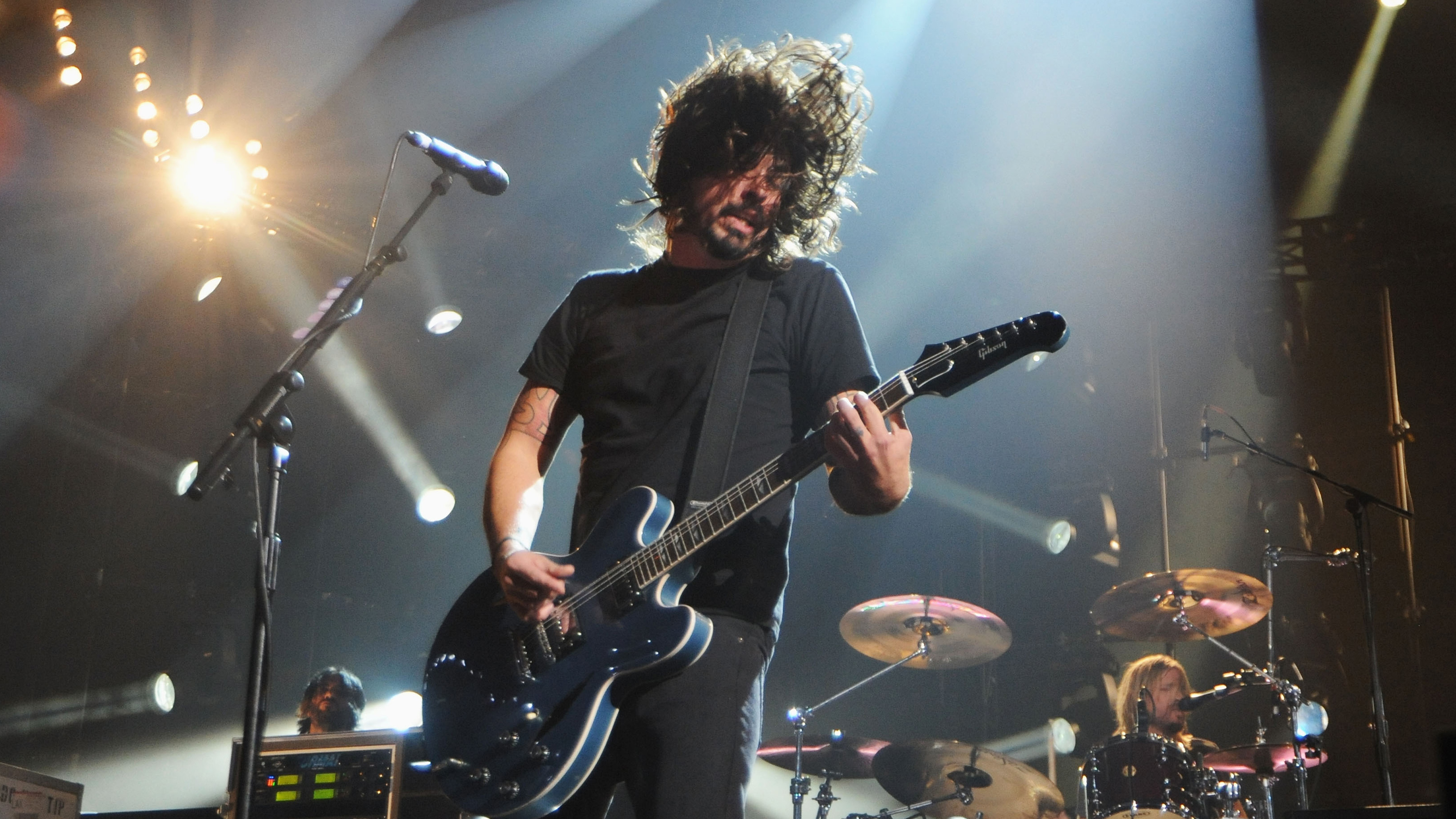
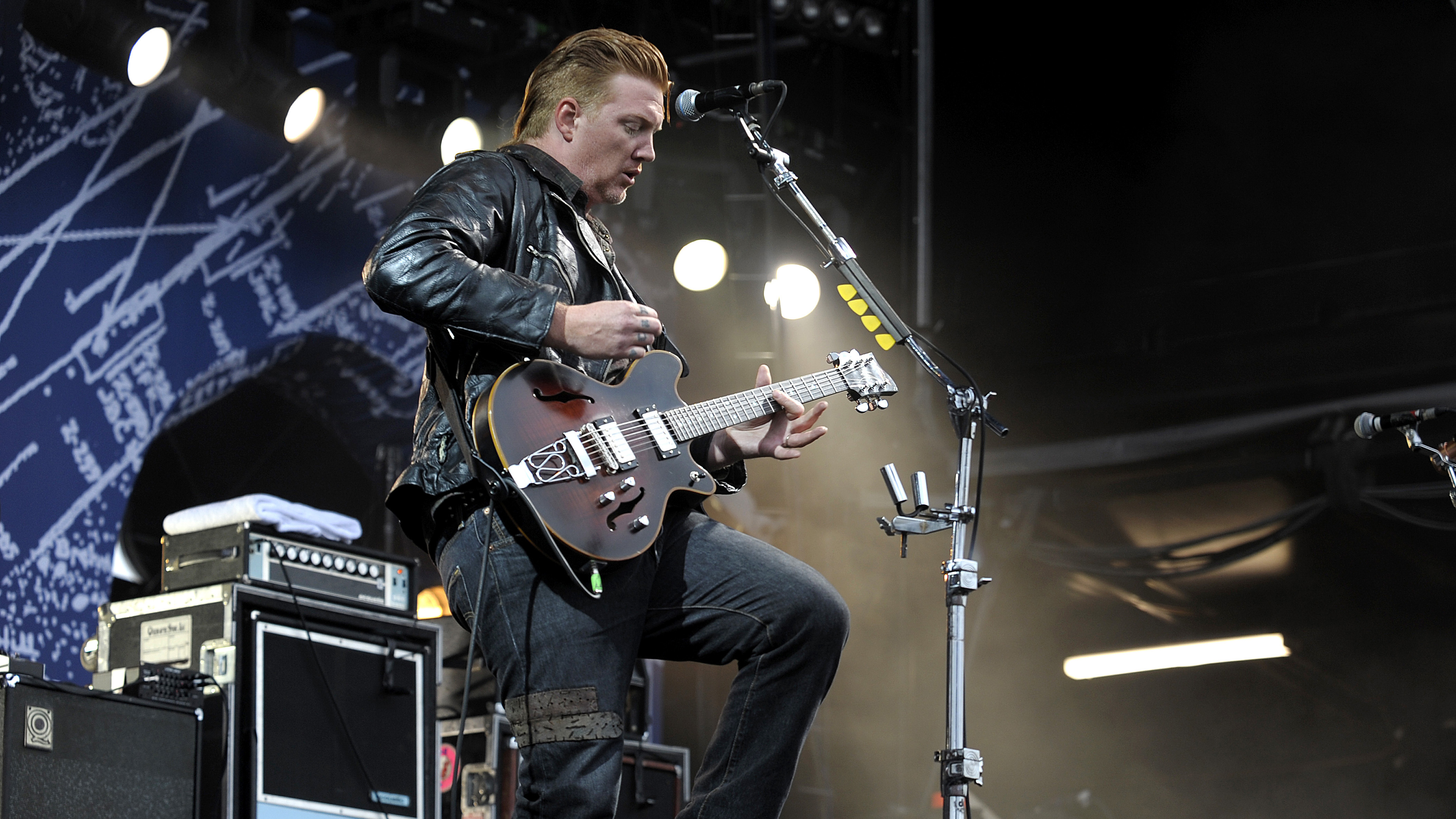
“For years Al and I have been using tuners – radio tuners – it’s one of the greatest guitar amps you can own. Go to a jumble sale – an old tuner and that circuitry and those tubes are better than a brand new Marshall. I’ll put Al with his home tuner against anyone with a new amp.
"I’m not saying old stuff is the best stuff, there’s some great new products. Old is always best is a silly notion, just not fair, but we’ve gotten more success out of a home tuner set on the ‘tape recorder’ setting because it’s hotter, and then you have bass and treble and a loudness button. That sounds like a great button doesn’t it? The loudness button.”
Hollowbodies appear quite often in your guitar collection, can you tell us a bit about those?
Dave Grohl: “I went to a guitar shop in 1992, a place called Southworth Guitars in Maryland, this is maybe just after I’d got my first Nirvana cheque. You know, being the drummer, I bought a guitar! I knew that I wanted something that I could play at home and I didn’t want a Les Paul or a Strat – what good is that when you’re sitting on the couch?
"So I looked at the hollowbodies and I saw one that had a peculiar neck on it with a strange headstock that looked like a 335, but had diamond f-holes. It was the Trini Lopez guitar, a 1966 or something, but that guitar became my number one guitar that I used. It’s one of the only guitars that I record with, so I’ve used it on every Foo Fighters record, every Foo Fighters song.
"That’s the guitar. I think… it’s the perfect guitar; it’s versatile, it’s a hollowbody, it has this beautiful resonance that has just enough… it almost sounds like it has a gate to it. It sounds great clean, it sounds great dirty, it sounds great through an AC30, it sounds great blasted through a rig.”
Is it more compressed or open?
Dave Grohl: “It can do both depending on how you use it. I never stuffed them, I’ve never put anything in them, but it has this nice resonance to it that’s almost like a coil in a way. It’s really, what’s the word I’m looking for, it’s sensitive to however you use it. If you need it to be a short blast it will be, if you need it to have this beautiful bright chime it can.”
How did your signature Gibson come about from that?
Dave Grohl: “Gibson came to me three or four years ago and mentioned it. I said, Are you kidding? I don’t even read music! This is great! So they asked what my favourite guitar was and I told them the one guitar that I used and felt most comfortable with over the last almost 20 years is this Trini. Gibson was doing the Inspired By series and so it turned into the Dave Grohl Inspired By DG-335 based on the Trini Lopez guitar.
"I love it. I use four of them on the road and they’re indestructible. They’re great and they’re ‘road’ guitars, they’ll last a year-and-a-half on tour with me throwing it, dropping it, sweating all over it, dumping water all over it and beating the shit out of it. I’ll be six songs into a set, running around in an arena beating the fuck out of my guitar and it will still be in tune.”
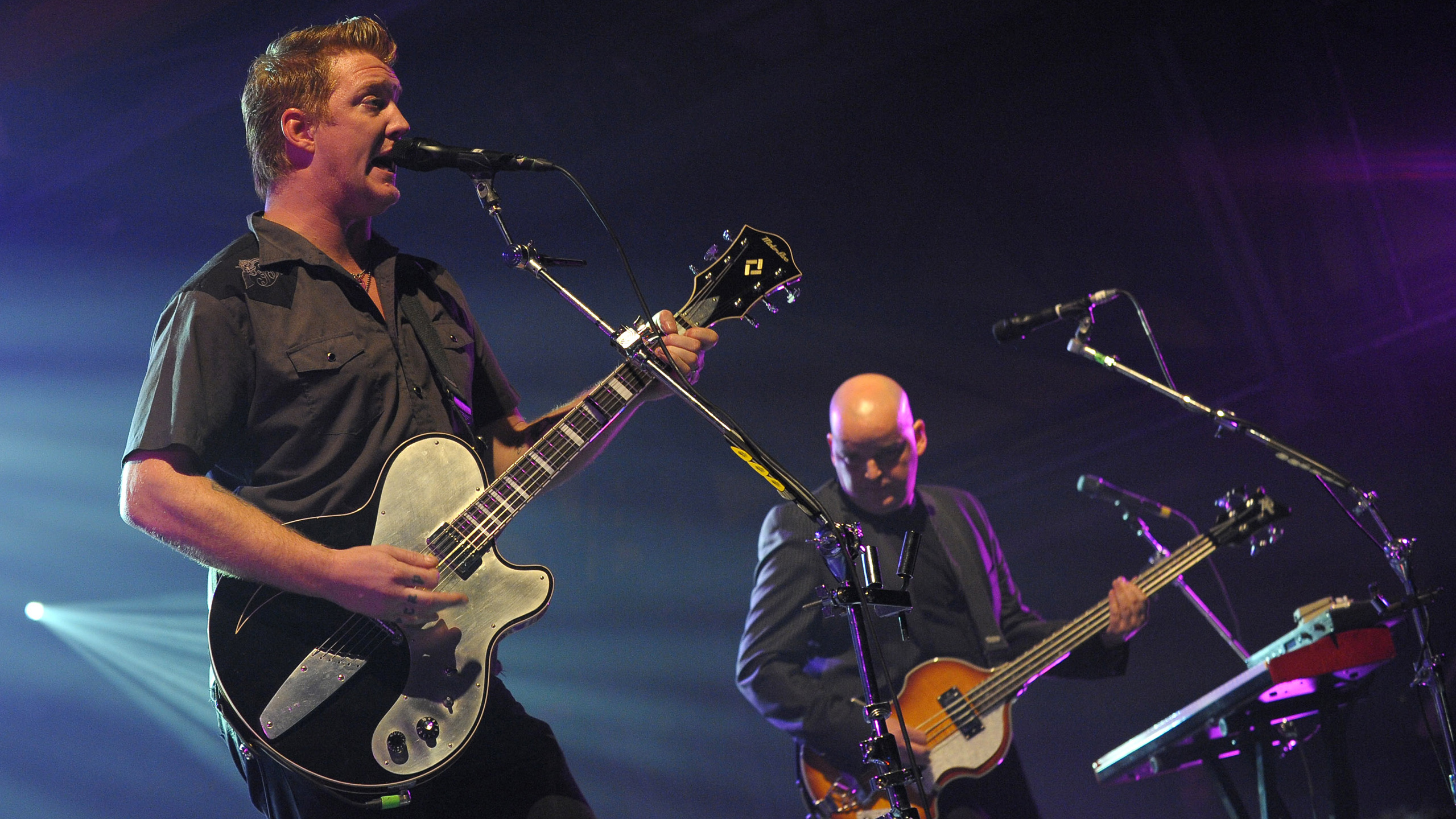
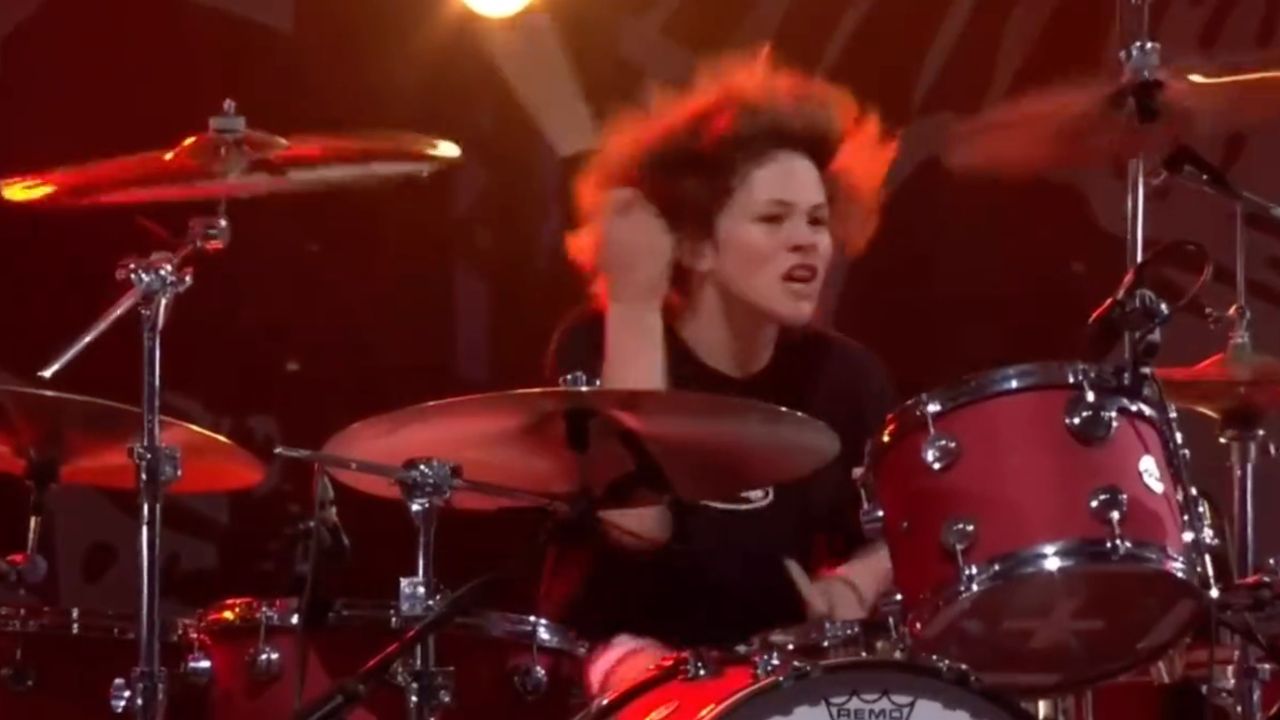
Taylor Hawkins Tribute Concert: 10 drum highlights you need to see
We spotted some MotorAve instruments in both guitar racks…
Josh Homme: “Al turned me onto these. Mark Fuqua makes them. The hole is almost big enough to steal the mid-range that gets you that wolfy [imitates a sucked-out, gnarly mid sound], but it doesn’t, because every piece is made with such intensity. That amalgam, it’s straight as an arrow.”
Alain Johannes: “I ordered a BelAire model and then Josh got one too. It’s the most ridiculously solid instrument. It just sits there. You should pick it up and play it – its the straightest guitar I’ve ever played. It doesn’t have that overly refined precision aspect to it that some custom instruments have, where no matter which register you’re in you end up flatlining. That’s the character of a vintage instrument, where each part of the neck has its own activity.”
Josh Homme: “It’s almost like its beautifully imperfect in that respect.”
Alain Johannes: “My God, what an instrument! It still has a soul in it. It takes Mark six weeks to make one.”
Josh Homme: “That’s because he’s been cutting pieces to get it ready and then it’s six weeks to put it together. He’s got a meticulous approach. It’s important to care about money a little, else you’re not going to have any, but his approach is like Andy and Hugh [Manson brothers – HM is John Paul Jones’s tech for the tour]. I bought Andy Manson’s Lotus De La Haye guitar.
“I have a problem with most luthier musician guys, they’re luthiers first, so they’re simply making art pieces for some museum somewhere, but not Andy! Both of those boys are making instruments they just don’t want to be like everyone else’s, so there’s a luthier touch to it and that in itself is a totally different animal.”
Any other notable others?
Josh Homme: “I also have the Matons, which I love.”
Dave Grohl: “I had an RD phase [Gibson RD Artist]. I was really into RDs for a while.”
Was that Krist Novoselic’s influence?
Dave Grohl: “He had RD and Grabber basses. But I think what happened was that I saw one in a store and I thought, Wow this thing weighs 40 pounds! I had a Gibson Explorer for a long time. I don’t know anything about guitars. If it sounds good when you play it, play it.”
Was there anything about Kurt Cobain’s playing in terms technique or attitude that you brought to your own guitar playing?
Dave Grohl: “I think the best musicians play like their instrument is a direct extension of their personality. Kurt was that way. When I listened to his guitar playing it’s like Kurt; it was really simple and understated, this humble, cynical version of playing guitar. If Kurt could do something wrong, he would do it. So it was never a matter of proficiency, it was a matter of honesty and feel, so the dissonance or the mistakes were meant to complement the song, because that’s how he felt.
"In that way there’s a part of me that has a disregard of all the same things he didn’t care about, but at the same time I try my hardest to be a good guitar player. But I can only do so much [laughs]. I’m resigned to just being that rhythm guy for the rest of my life and not worrying about any of that [imitates guitar widdling]."
What about technique generally?
Dave Grohl: “For me it’s important in the Foo Fighters that we have that textural side and there’s colouration of what we do, but I consider myself Malcolm Young, that’s how I like to play guitar. I like to play guitar like a drummer. If you listen to a song such as Everlong or The Pretender, they are good examples.
"When I look at a guitar I almost look at it like a drum set where your low E string is the kick drum your A and D are the snare and so when you’re writing riffs I use the lower notes as kick and snare and the higher notes as cymbals. If a chorus comes up, you can imagine me washing on the cymbals, so when I play it on guitar, I’m usually letting the bottom strings ring out underneath a chord that moves around."
You must relate to that better than most guitarists would?
Dave Grohl: “It works! It’s just the way that I see it and so when the Foo Fighters write music, Taylor [Hawkins] and I just sit in a room and it’s riff after riff after riff. It’s like two drummers jamming together, except one of them has a guitar!
"I have the most respect for the rhythm guitarists of the world. James Hetfield? That guy is a fucking unbelievable rhythm guitarist. Malcolm Young, he’s amazing. Keith Richards too – he’s got swing and groove in the way he plays. It’s a big part of the song, so I don’t fuck around too much – just get in there and go.”
Josh Homme's Crooked Rig
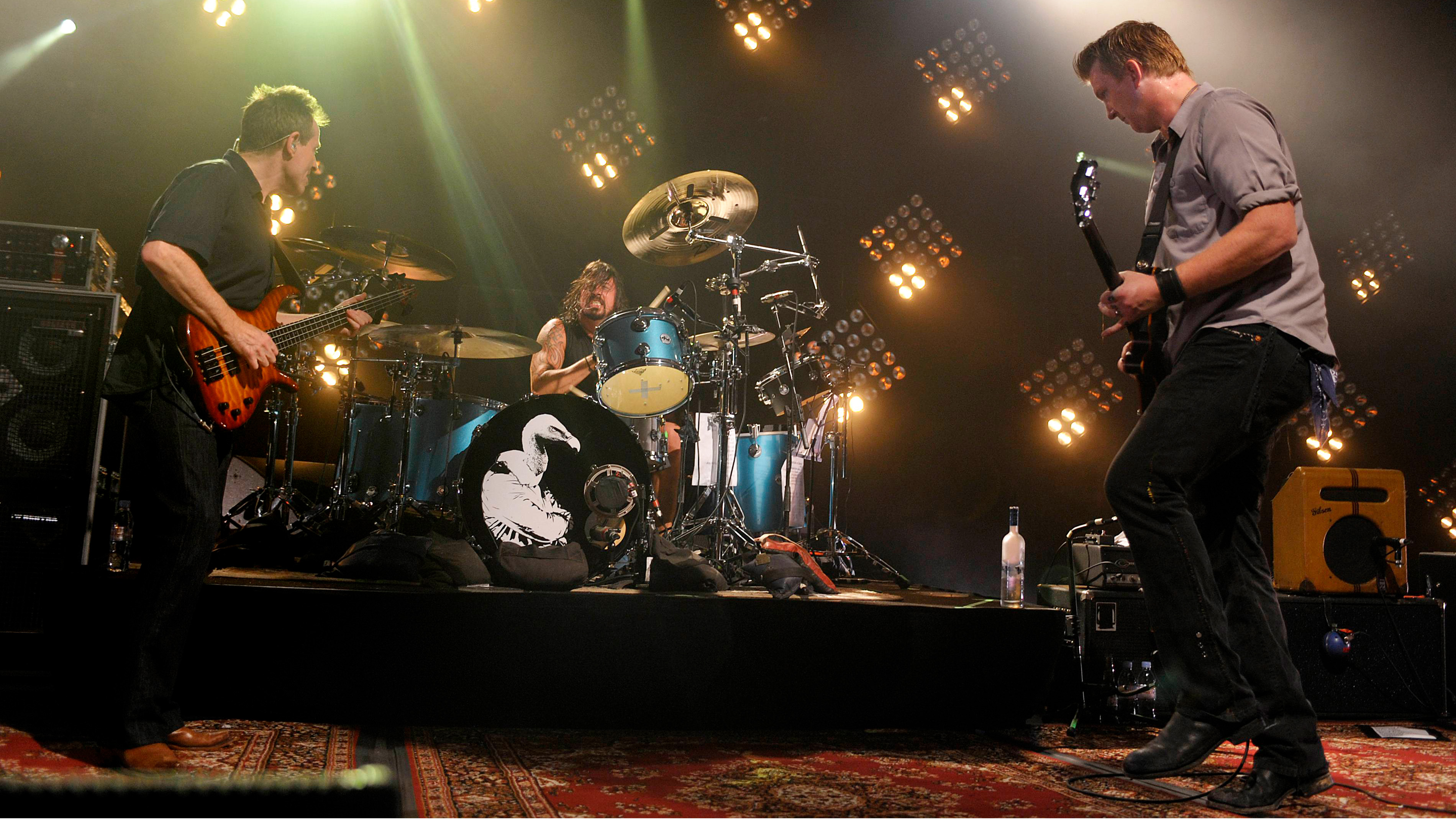
Ally Christie has his work cut out on the Them Crooked Vultures tour, as he caters for both Josh Homme and Alain Johannes’ rigs. Ally kindly guided us through Josh’s usually highly secretive rig.
“The guitars go into the pedals on two pedalboards, one each side of the mic stand, with pedals placed for ease of access for his rather large feet. Pedals that run after one another in the signal chain might be on different boards.
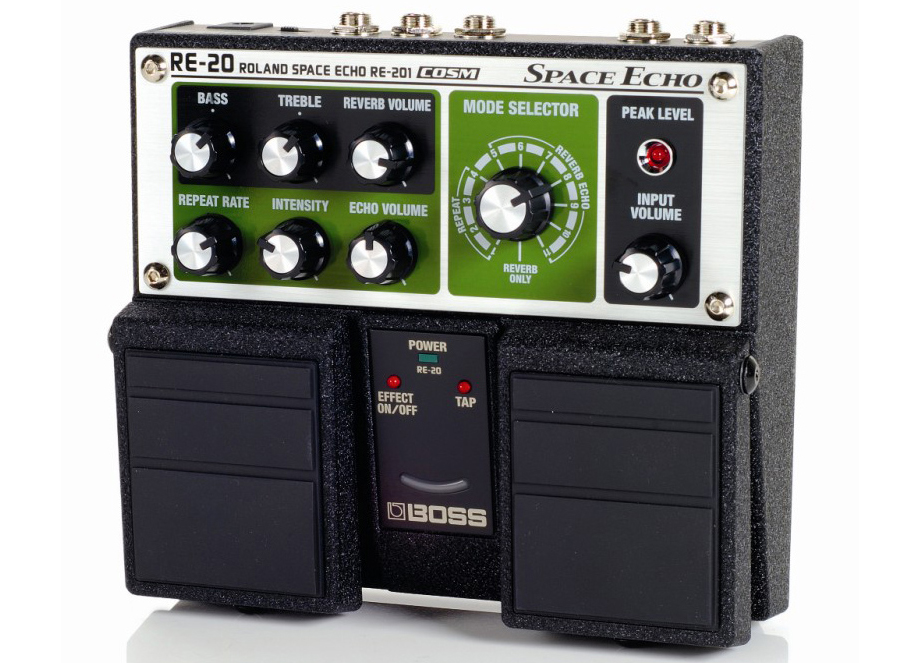
“Then it’s an Electro-Harmonix Octave Multiplexer, Fulltone Ultimate Octave, Fulltone FB-3, Electro-Harmonix POG, vintage Morley Wah, Univox Super Fuzz, BOSS RE20, [Roland] Space Echo, SIB Echo Drive and then into a Moogerfooger Analog Delay and Low Pass Filter.
“After the pedals, the signal goes into the Little Labs PCP Amp Distro unit, which splits the signal three ways: one into the 1938 Gibson EH-185 combo, one into the Silvertone tube Twin Twelve head and one into a BOSS EQ pedal, then a Fulltone Fat Boost (FB-2) and then into a Teisco Checkmate 25 head. Each head runs an Ampeg 2 x 12 with vintage Celestions inside.
“We have three Matons, the first one is a model they make for Josh and it’s tuned GGDGEB. There’s another Maton here as a back-up that was made for his wife Brody Dalle [of The Distillers/Spinerette fame]. Then there’s an American Tele, as regular as it comes, together with a white back-up – it’s actually Al’s. Then there’s a Epiphone Lucille.”
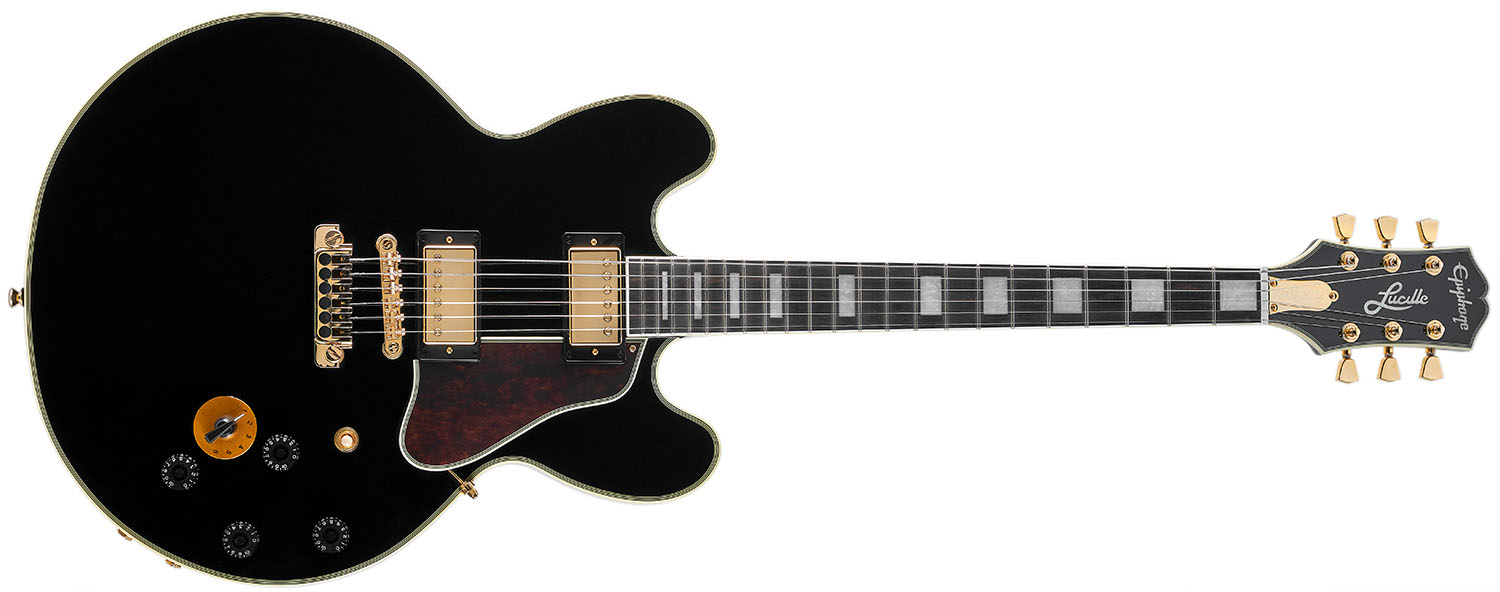
Are they all stock? “The Matons are all built to whatever spec he wants and they’re a little bit bigger than the regular Matons ’cos he’s big lad. The Epiphone is stock, Josh loves Epiphone guitars and he doesn’t like buying expensive ones – he’s got maybe 50 guitars back home but they’re nearly all in the $200 price range.
“The drop-A tuned MotorAve BelAire runs AAEADG, while the Epiphone Dot has a small mod with a bridge Manson MBK-2 pickup. He loves this guitar and he did a lot of the record with it.” And strings? “I’ve got Josh using Dunlop strings, he’s switched from using a wound G string and has come down in gauges considerably from the Dean Markley 0.013s he uses with QOTSA.
"The Telecasters are the 0.010-0.052 nickel-wound steel strings and all others are 0.011-0.050s, except the MotorAve, which has a 0.065 Dunlop nickel-plated steel bass string on it for the low A, with the rest of the guitar using the 0.011-0.038 from a 0.011-0.050 set. A Korg Pitchblack tuner sits on one of the Ampeg cabs to sort the tuning.”